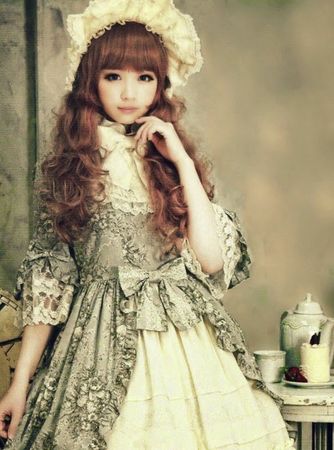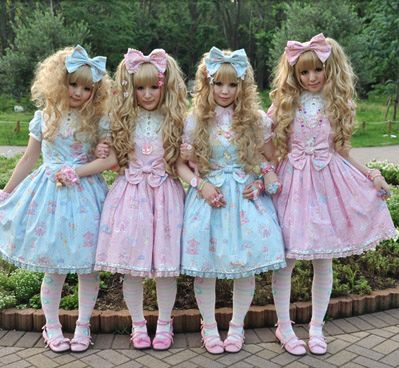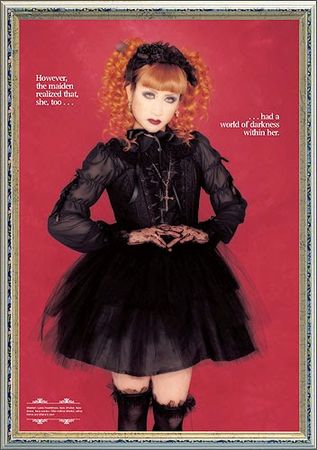Lolita fashion
Lolita fashion (ロリータ・ファッション, rorīta fasshon) is a subculture from Japan that is highly influenced by Victorian clothing and styles from the Rococo period. A very distinctive property of Lolita fashion is the aesthetic of cuteness. This clothing subculture can be categorized into three main substyles: 'gothic', 'classic', and 'sweet'. Many other substyles such as 'sailor', 'country', 'hime' (princess), 'ero' (erotic), 'guro' (grotesque), 'qi' and 'wa' (based on traditional Chinese and Japanese dress), 'punk', 'shiro' (white), 'kuro' (black), and 'steampunk' lolita also exist. This style evolved into a widely followed subculture in Japan and other countries in the 1990s and 2000s and may have waned in Japan as of the 2010s as the fashion became more mainstream.
Description
The main feature of Lolita fashion is the volume of the skirt, created by wearing a petticoat or crinoline. The skirt can be either bell-shaped or A-line shaped. Components of the lolita wardrobe consist mainly of a blouse (long or short sleeves) with a skirt or a dress, which usually comes to the knees. Lolitas frequently wear wigs in combination with other headwear such as hair bows or a bonnet (similar to a Poke bonnet). Lolitas can also wear Victorian style drawers under their petticoats. For further effect some Lolitas use knee socks, ankle socks or tights together with either high heels or flat shoes with a bow are worn. Other typical Lolita garments are a jumperskirt (JSK) and one-piece (OP).
- Examples of Lolita styles
History
Although the origin of the fashion is unclear, at the end of the 1970s a new movement known as Otome-kei was founded, which slightly influenced Lolita fashion since Otome means maiden and maiden style looks like a lesser elaborated Lolita style. Before Otome-kei emerged, there was already a rise of the cuteness culture in the earlier seventies; during which there was a high emphasis on cute and childish handwriting in Japanese schools. As a result of that the company Sanrio began experimenting with cute designs. The cuteness style, known as kawaii style, became popular in the 1980s. After Otome-kei, Do-It-Yourself behavior became popular, which led to the emergence of a new style called 'doll-kei', the predecessor of Lolita fashion.
In the years of 1977–1998, a large part of the Harajuku shopping district closed for car traffic on Sundays. The result was an increase in interaction between pedestrians in Harajuku. When brands like Pink House [ja] (1973), Milk (1970), and Angelic Pretty (1979) began to sell cute clothing, that resulted in a new style, which would later be known as 'Lolita'. The term lolita first appeared in the fashion magazine Ryukou Tsushin in the September 1987 issue. Shortly after that Baby, The Stars Shine Bright (1988), Metamorphose temps de fille (1993), and other brands emerged. In the 1990s, lolita became more accepted, with visual kei bands like Malice Mizer and others rising in popularity. These band members wore elaborate clothes that fans began to adopt. During this time Japan went through an economic depression, leading to an increase in alternative youth and fashion cultures such as gyaru, otaku, visual kei, and lolita, as well as visual kei inspired clothing such as Mori, Fairy Kei and Decora The lolita style spread quickly from the Kansai region and finally reached Tokyo, partly due to the economic difficulties there was a big growth in the cuteness and youth cultures that originated in the seventies.
In the late nineties, the Jingu Bashi (also called the Harajuku Bridge) became known as meeting place for youth who wore lolita and other alternative fashion, and lolita became more popular causing a spurt of lolita Fashion selling warehouses. Important magazines that contributed to the spread of the fashion style were the Gothic & Lolita Bible (2001), a spin-off of the popular Japanese fashion magazine KERA [ja] (1998), and FRUiTS (1997). It was around this time when interest and awareness of Lolita Fashion began entering countries outside of Japan, with The Gothic & Lolita Bible being translated into English, distributed outside of Japan through the publisher Tokyopop, and FRUits publishing an English picture book of the Japanese Street Fashion in 2001. As the style became further popularized through the Internet, more shops opened abroad, such as Baby, The Stars Shine Bright in Paris (2007), and in New York (2014).
Over time, the youth that gathered in Harajuku or at Harajuku Bridge disappeared. One possible explanation is that the introduction of fast fashion from retailers H&M and Forever 21 has caused a reduction in the consumption of street fashion. FRUiTS ceased publication while Gothic & Lolita Bible was put on hiatus in 2017.
Sources of inspiration
Western culture has influenced Lolita fashion. The book Alice in Wonderland (1865), written by Lewis Carroll, has inspired many different brands and magazines, such as Alice Deco. The reason that the character Alice was an inspiration source for the Lolita, was because she was an ideal icon for the Shōjo (shoujo)-image, meaning an image of eternal innocence and beauty. The first complete translation of the book was published by Maruyama Eikon in 1910, translated under the title Ai-chan No Yume Monogatari (Fantastic stories of Ai). Another figure from the Rococo that served as a source of inspiration was Marie Antoinette; a manga The Rose of Versailles (Lady Oscar) based on her court, was created in 1979.
Popularization
People who have popularized the Lolita fashion were Yukari Tamura, Mana and Novala Takemoto. Novala wrote the light novel Kamikaze Girls (2002) about the relationship between Momoko, a lolita girl and Ichigo, a Yanki. The book was adapted into a movie and a manga in 2004. Novala himself claims that "There are no leaders within the lolita world". Mana is a musician and is known for popularizing the Gothic Lolita fashion. He played in the rock band Malice Mizer (1992–2001) and founded the heavy metal band Moi Dix Mois (2002–present). Both bands are a part of the visual kei movement, whose members are known for eccentric expressions and elaborate costumes. He founded his own fashion label, known as Moi-même-Moitié in 1999, which specializes in Gothic Lolita. They are both very interested in the Roccoco period.
The government of Japan has also tried to popularize Lolita fashion. The Minister of Foreign Affairs in February 2009, assigned models to spread Japanese pop culture. These people were given the title of Kawaa Taishi (ambassadors of cuteness). The first three ambassadors of cuteness were model Misako Aoki, who represents the Lolita style of frills-and-lace, Yu Kimura who represents the Harajuku style, and Shizuka Fujioka who represents the school-uniform-styled fashion. Another way that Japan tries to popularize Japanese street fashion and Lolita is by organizing the international Harajuku walk in Japan, this should caused other foreign countries would organize a similar walk.
Possible reasons for the popularity of Lolita fashion outside of Japan are a big growth in the interest of Japanese culture and use of the internet as a place to share information, leading to an increase in worldwide shopping, and the opportunity of enthusiastic foreign Lolitas to purchase fashion. The origin of the Japanese influences can be found in the late nineties, in which cultural goods such as Hello Kitty, Pokémon, and translated mangas appeared in the west. Anime was already being imported to the west in the early nineties, and scholars also mention that anime and manga caused the popularity of Japanese culture to rise. This is supported by the idea that cultural streams have been going from Japan to the west, and from the west to Japan.
Motives Lolita is seen as a reaction against stifling Japanese society, in which young people are pressured to strictly adhere to gender roles and the expectations and responsibilities that are part of these roles. Wearing fashion inspired by childhood clothing is a reaction against this. This can be explained from two perspectives. Firstly, that it is a way to escape adulthood and to go back to the eternal beauty of childhood. Secondly, that it is an escape to a fantasy world, in which an ideal identity can be created that would not be acceptable in daily life.
Some Lolitas say they enjoy the dress of the subculture simply because it is fun and not as a protest against traditional Japanese society. Other motives could be that wearing the fashion style increases their self-confidence or to express an alternative identity.
| Cosplay / Japanese Street Fashion subcultures |
|---|
|
Chat rooms • What links here • Copyright info • Contact information • Category:Root


